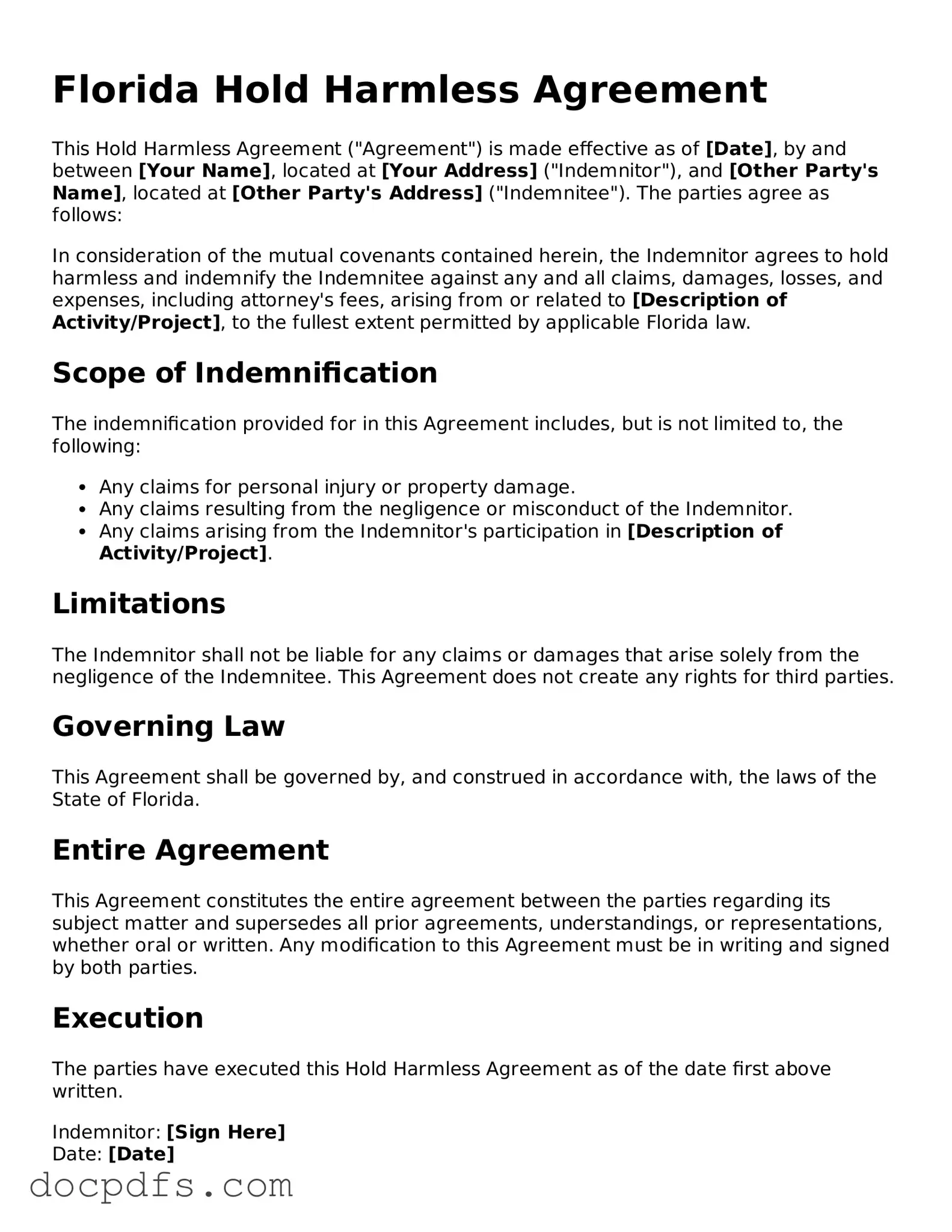What is a Florida Hold Harmless Agreement?
A Florida Hold Harmless Agreement is a legal document that protects one party from liability for any injuries or damages that may occur during a specific activity or event. This agreement is commonly used in various situations, such as when renting property, hosting events, or engaging in activities that involve potential risks.
Who typically uses a Hold Harmless Agreement in Florida?
Various individuals and organizations utilize Hold Harmless Agreements, including:
-
Property owners renting out their spaces
-
Event organizers hosting gatherings
-
Contractors and subcontractors in construction projects
-
Sports organizations and recreational facilities
Each of these parties seeks to limit their liability for unforeseen incidents that may arise during their activities.
What are the key components of a Hold Harmless Agreement?
A well-drafted Hold Harmless Agreement typically includes the following elements:
-
Identification of Parties:
Clearly state who is involved in the agreement.
-
Scope of Activities:
Describe the activities or events covered by the agreement.
-
Liability Waiver:
Include a clause that outlines the extent of liability being waived.
-
Indemnification Clause:
Specify that one party agrees to indemnify the other for any claims or damages.
-
Signatures:
Ensure that all parties sign the agreement to make it legally binding.
Is a Hold Harmless Agreement legally enforceable in Florida?
Yes, a Hold Harmless Agreement can be legally enforceable in Florida, provided it meets certain requirements. The agreement must be clear, unambiguous, and voluntarily signed by all parties involved. However, it is important to note that Florida courts may not enforce agreements that attempt to waive liability for gross negligence or intentional misconduct.
Can a Hold Harmless Agreement protect against all types of liability?
No, a Hold Harmless Agreement cannot protect against all types of liability. While it can limit liability for ordinary negligence, it typically does not cover situations involving gross negligence or willful misconduct. Additionally, certain statutory liabilities may not be waived, so it is essential to consult with a legal professional to understand the limits of the agreement.
How do I create a Hold Harmless Agreement?
Creating a Hold Harmless Agreement involves several steps:
-
Identify the parties involved and their roles.
-
Clearly outline the activities or events covered.
-
Draft the agreement using straightforward language.
-
Include all necessary clauses, such as liability waivers and indemnification.
-
Have all parties review and sign the document.
While templates are available online, it may be beneficial to consult a legal professional to ensure the agreement meets all legal requirements.
What should I do if someone refuses to sign the Hold Harmless Agreement?
If someone refuses to sign the Hold Harmless Agreement, consider discussing their concerns openly. They may have valid reasons for hesitance, such as misunderstanding the terms or feeling uncomfortable with the liability waiver. Addressing their concerns may lead to a resolution. If they still refuse, you may need to evaluate the risks involved in proceeding without the agreement.
How long is a Hold Harmless Agreement valid?
The validity of a Hold Harmless Agreement typically depends on the terms outlined within the document itself. Many agreements specify a duration, often tied to the length of the event or activity. If no specific time frame is mentioned, the agreement may remain in effect until the completion of the covered activities. Always refer to the agreement for clarity.
Can a Hold Harmless Agreement be revoked?
Yes, a Hold Harmless Agreement can be revoked, but this usually requires mutual consent from all parties involved. If one party wishes to revoke the agreement, they should communicate this intention clearly and in writing. It is advisable to consult a legal professional to ensure that the revocation is executed properly and to understand any implications.
Where can I find a template for a Florida Hold Harmless Agreement?
Templates for Hold Harmless Agreements can be found online through various legal websites, document preparation services, or local government resources. However, while templates can provide a useful starting point, it is important to customize the agreement to fit your specific needs. Consulting a legal professional is recommended to ensure compliance with Florida law.
